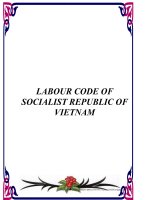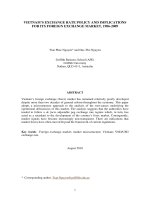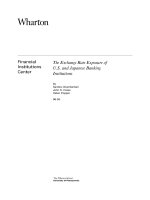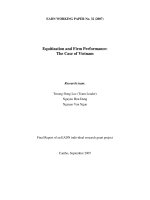EXCHANGE RATE POLICY OF VIETNAM pps
Bạn đang xem bản rút gọn của tài liệu. Xem và tải ngay bản đầy đủ của tài liệu tại đây (393.23 KB, 23 trang )
Powerpoint Templates
Page 1
Powerpoint Templates
EXCHANGE RATE
POLICY OF
VIETNAM
Presented by: Tran Thi Thu Huong
Powerpoint Templates
Powerpoint Templates
Page 2
Vietnamese currency: Vietnam
dong (VND)
Powerpoint Templates
Page 3
We also have coins.
But people don’t really
like using them cause
their inconvenience
(easily being lost…)
Powerpoint Templates
Page 4
State Bank of Vietnam (SBV) is in charge of
conducting monetary policy
Powerpoint Templates
Page 5
Overview of exchange rate regime
1. Hard peg
•
Regime with no separate legal tender – incl.
another currency as legal tender (formal
dollarization) and currency union
•
Currency board
2. Intermediate regimes
•
Conventional fixed peg against a single currency
or a basket of currencies
•
Pegged exchange rates within horizontal bands
•
Crawling pegs
•
Crawling bands
3. Floating regimes
•
Managed floating with no predetermined path for
exchange rate
•
Independent floating
Powerpoint Templates
Page 6
Exchange rate arrangements in
Vietnam
•
Before March 1989: A multiple exchange
rate system (with three-tier exchange rate
system), fixed exchange rate policy
•
Three-tier ER system: official ER for
foreign trading, non-trading ER and
internal ER used in business relations
between banks and other domestic
business entities.
•
These rates were also used in state
budgeting in regard to foreign aid mainly
coming from the former Council for Mutual
Economic Assistance (CMEA) and the
former Soviet Union using the Transfer
Ruble.
•
·
Powerpoint Templates
Page 7
Before March 1989…
•
ERs were set by the government at fixed
levels based on economic and granting
agreements between the government of
Vietnam and other related countries
•
This led to high trade deficit and the large
difference in the official and parallel
exchange rate.
caused problems for the government
budget promoted illegal activities in the
black market.
Powerpoint Templates
Page 8
Mar 1989 - Feb 1999:
VND has been pegged to the USD with
several discrete realignments.
The multi-tier ER system was unified into a
single official ER (OER) set by the State Bank
of Vietnam (SBV).
· The OER was adjustable in principle, based
on inflation rates, interest rates, balance of
payment (BOP) stance and the ER in the
parallel/free foreign exchange market; based
on
Powerpoint Templates
Page 9
Commercial banks were allowed to set
exchange rates for their own
transactions within a band of 5% (this
band change according to economic
situation)
Powerpoint Templates
Page 10
•
Establish some facilities: two transaction
floors (hanoi-HCMC), inter-bank FE
market
•
The official ERs followed the rates of free
market but were still at levels that
overvalued the VND
•
ER policy played an important role on
controlling inflation, attracting FDI, and
encouraging domestic currency deposits
Powerpoint Templates
Page 11
From Feb 1999 to 2007
•
ER system was reclassified as a crawling peg
(A situation in which one currency links its value to that of
another currency, but allows it to fluctuate within certain
limits) effective in the following day, an average
inter-bank rate of exchange would be official
ER.
•
Instead of determining the official ER, the SBV
announced the interbank average ER and the
fluctuation band was stipulated around the
interbank average ER.
•
Trading band was narrowed to 0.1%(extended
to 0.25% for spot transactions since 2002)
•
The new regulation seemed to make the ER
management more market-oriented.
Powerpoint Templates
Page 12
1999-2007…
•
Both official and parallel exchange
rates remained stable and the
differences between them were
narrowed
•
ER has de facto been pegged to the
US dollar in recent years, then REER
has appreciated by about 4.5 percent
since the end of 2004 (IMF)
•
The import coverage of reserves has
remained low (8.5 weeks)
Powerpoint Templates
Page 13
VND/USD exchange rate
history
The VND has
been depreciating
a lot
Powerpoint Templates
Page 14
Latest data:
The graph below shows historical exchange rates
between the Vietnamese Dong (VND) and the US
Dollar (USD) between 5/16/2011 and 6/14/2011
Transaction band: -/+ 1%
Powerpoint Templates
Page 15
WHY VND IS CONTINUNING
LOSE VALUE AGAINST USD?
•
First is about inflation
•
Vietnam reaches the very high inflation
rate in recent years.
•
Domestic inflation may add together
with inflation in the world. Over the past
time, the deflation has been happened
all over the world: the increase in prices
of oil, foodstuffs…
•
Furthermore, domestic prices are under
the “double” increased pressure
because VND loses its value compared
to USD while USD loses its value
compared to many hard currencies.
Powerpoint Templates
Page 16
•
In practice, inflation in Vietnam for over
3 years (2007-2009) was above 40
percent, while inflation in America was
only around 20 percent in the same
period
•
Secondly, the rapid increase in credit
and total payment means over many
years when implementing loosen
monetary policies to ensure the high
economic growth rate is an important
reason that makes VND price reduce
compared to USD regardless of USD
price reduction trend in the world. When
this adjustment meet the necessary
threshold, the exchange rate between
USD/VND shall close to the general
exchange rate in the world.
Powerpoint Templates
Page 17
the demand for and supply of
foreign currencies is imbalanced
•
Vietnam continues to import a lot.
•
In 2009: Trade deficit is around 12 billion
USD. The balance of payment is minus at
1.9 billion USD.
•
Facing to domestic inflation, persons who
have money have found their safe in USD
and gold
•
Because of these above factors, demand
for USD has increased a lot and the
imbalance of USD’s demand and supply
rise also.
Powerpoint Templates
Page 18
The outcome of loss in VND value
•
the loss in VND value may make
national debt burden higher. Our
national debts now are relatively high,
nearly the warning level. If the exchange
rate of VND/USD is 18,000, total foreign
debts shall be VND 396,000 billion,
higher than the estimated state budget
revenue of 2009 (VND 390,000 billion).
If the exchange rate is VND 20,000,
total foreign debts shall be VND
440,000, VND 44,000 billion higher,
accounting for 11 percent of the
estimated state budget revenue of 2009
Powerpoint Templates
Page 19
Monetary policy moves to tight
to control inflation
•
People worries and complaint a lot about
inflation
•
They feel like losing money when
shopping, decrease their living standard.
•
If inflation is too high, it can lead to the
unstable in society and people lose faith in
government.
Powerpoint Templates
Page 20
Actions from government
•
Agree to trade off between
inflation and growth rate.
•
Now the primary objectives is
to control inflation.
•
SBV conducts a tighten
monetary policy
Powerpoint Templates
Page 21
Control inflation…
•
SBV asked commercial banks to
significantly reduce outstanding loans for
non-manufacturing sectors, especially real
estate and securities, compared to figures
recorded in 2010.
•
Under the SBV's current regulations, the
interest rate for dong deposits is capped at
14 percent per annum while the annual
lending rate stands at between 17 and 18
percent.
•
Remove foreign trading in black market to
control VND/USD rate
Powerpoint Templates
Page 22
•
Now the trading of foreign currencies is
totally done by commercial banks with
listed rate. This create difficulties for
foreign exchange companies in buying
and selling foreign currencies. However it
is the price to be paid for lower inflation.
Powerpoint Templates
Page 23
Thank you









